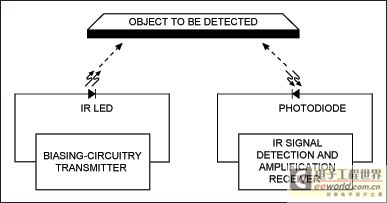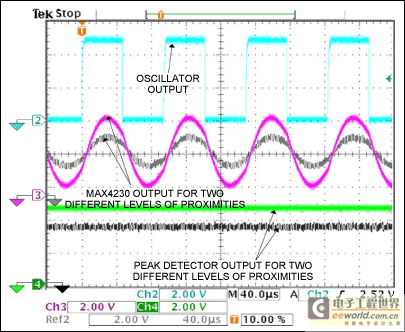This article describes a simple IR transceiver design that generates an IR signal modulated at a 10kHz carrier frequency and then amplifies the reflected signal using a single op amp (MAX4230) that is also configured as a second-order bandpass filter to demodulate the 10kHz IR receive signal.
This design idea was also published in the August 6, 2009 issue of
EDN
magazine.
IR proximity sensors are widely used to detect the presence of an object, the distance to a reference object, or both. Specific applications include: speed measurement, automatic faucets, automatic counters or conveyor belt object detection, printer paper edge detection, and other applications. Proximity detection technology is also used in the new generation of smart phones, which can automatically turn off the LCD touch screen when the phone is pressed under the chin or ear to prevent accidental operation of the touch screen.
To detect an object, the proximity detection sensor first transmits IR (infrared) pulses to the target and then "listens" for the reflected signal to detect the presence of any reflected pulses (
Figure 1
). The IR LED transmits the IR signal, and any reflected signal can be captured by the IR photodetector. The strength of the reflected signal is inversely proportional to the distance between the target and the IR transceiver. The closer the distance, the stronger the IR reflected signal. The output of the photodetector can be calibrated to determine the exact distance of the target (a distance detection threshold can be set to determine whether the target exists).
Figure 1. Basic principle of IR proximity detection sensor
The photodiode detects the IR signal reflected by the target, and can also detect the IR signal generated by the surrounding environment. Designers need to filter out these IR noises to avoid false detection. A common solution is to modulate the IR signal emitted by the LED to an appropriate frequency. The receiver only detects the modulated IR signal to ensure that the actual detected signal only comes from the reflection of the target object.
The IR proximity detection sensor shown in
Figure 2
has a simple transmitting and receiving circuit. The transmitting circuit includes an IR LED (IR11-21C) with a wavelength of 940nm, which is turned on and off at an oscillation frequency of 10kHz. The transmitting power is controlled by adjusting the LED current, thereby controlling the detection range. To reduce power consumption, the transmitting circuit usually uses a small duty cycle (typically 10%) transmitting pulse.
Figure 2. Simple IR transceiver, detecting the presence of an object and the distance between the object and the transceiver.
The receiver circuit demodulates and amplifies the IR signal detected by the photodiode (PD15-22C), which peaks at 940nm.
The photodiode
output is AC-coupled to the noninverting input of the op amp. The AC coupling allows the 10kHz signal to pass, while the 300Hz cutoff frequency established by the coupling capacitors suppresses DC noise and IR background noise at the op amp input.
Low-noise, wideband, rail-to-rail input/output op amps (
MAX4230
) are the best choice for signal demodulation and amplification in this type of circuit design. In addition, the excellent RF rejection of the op amp helps avoid the 217Hz buzzing noise common in GSM cell phones. In the IR receiver, the op amp circuit is configured as a second-order bandpass filter with a gain of 100 and a center frequency of 10kHz, allowing the op amp to demodulate the incoming IR signal using its bandpass filter while amplifying the incoming IR signal.
When no IR signal is input, the op amp is biased at 2.5V. When a 10kHz IR signal is present at the input, the output varies around 2.5V, with a dynamic range of 5V. The output of the op amp drives a simple diode detector, which rectifies the 10kHz signal and provides a DC signal proportional to the signal amplitude. The amplitude of the analog output signal (OUT) is proportional to the distance of the target from the IR transmitter. This output signal can be used directly for detection or it can be fed into an ADC for further processing. The operation of the circuit can be clearly described by measuring the signal waveforms at different nodes of the circuit.
Figure 3
shows the signal waveforms when the distance is 1.2 inches and 1.4 inches from the IR transceiver. Note that these waveforms are labeled with specific numbers corresponding to different nodes of the circuit.
Figure 3. The waveforms shown in the figure are generated by the circuit of Figure 2 and represent the reflected signal of an object 1.2 inches and 1.4 inches away from the IR transceiver.



Reference address:High-speed op amps support infrared (IR) proximity detection designs



Previous article:Simulation Design of X-Band Microstrip Bandpass Filter
Next article:Design considerations for electronic sphygmomanometers
- Popular Resources
- Popular amplifiers
Recommended Content
Latest Analog Electronics Articles
- High signal-to-noise ratio MEMS microphone drives artificial intelligence interaction
- Advantages of using a differential-to-single-ended RF amplifier in a transmit signal chain design
- ON Semiconductor CEO Appears at Munich Electronica Show and Launches Treo Platform
- ON Semiconductor Launches Industry-Leading Analog and Mixed-Signal Platform
- Analog Devices ADAQ7767-1 μModule DAQ Solution for Rapid Development of Precision Data Acquisition Systems Now Available at Mouser
- Domestic high-precision, high-speed ADC chips are on the rise
- Microcontrollers that combine Hi-Fi, intelligence and USB multi-channel features – ushering in a new era of digital audio
- Using capacitive PGA, Naxin Micro launches high-precision multi-channel 24/16-bit Δ-Σ ADC
- Fully Differential Amplifier Provides High Voltage, Low Noise Signals for Precision Data Acquisition Signal Chain
MoreSelected Circuit Diagrams
MorePopular Articles
- Innolux's intelligent steer-by-wire solution makes cars smarter and safer
- 8051 MCU - Parity Check
- How to efficiently balance the sensitivity of tactile sensing interfaces
- What should I do if the servo motor shakes? What causes the servo motor to shake quickly?
- 【Brushless Motor】Analysis of three-phase BLDC motor and sharing of two popular development boards
- Midea Industrial Technology's subsidiaries Clou Electronics and Hekang New Energy jointly appeared at the Munich Battery Energy Storage Exhibition and Solar Energy Exhibition
- Guoxin Sichen | Application of ferroelectric memory PB85RS2MC in power battery management, with a capacity of 2M
- Analysis of common faults of frequency converter
- In a head-on competition with Qualcomm, what kind of cockpit products has Intel come up with?
- Dalian Rongke's all-vanadium liquid flow battery energy storage equipment industrialization project has entered the sprint stage before production
MoreDaily News
- Allegro MicroSystems Introduces Advanced Magnetic and Inductive Position Sensing Solutions at Electronica 2024
- Car key in the left hand, liveness detection radar in the right hand, UWB is imperative for cars!
- After a decade of rapid development, domestic CIS has entered the market
- Aegis Dagger Battery + Thor EM-i Super Hybrid, Geely New Energy has thrown out two "king bombs"
- A brief discussion on functional safety - fault, error, and failure
- In the smart car 2.0 cycle, these core industry chains are facing major opportunities!
- The United States and Japan are developing new batteries. CATL faces challenges? How should China's new energy battery industry respond?
- Murata launches high-precision 6-axis inertial sensor for automobiles
- Ford patents pre-charge alarm to help save costs and respond to emergencies
- New real-time microcontroller system from Texas Instruments enables smarter processing in automotive and industrial applications
Guess you like
- Simplifying Your Ethernet Design, Part 1: Ethernet PHY Basics and the Selection Process
- MSP432E401Y MCU intelligent car PID speed control code
- Embedded processors face side-channel attacks
- Do you know the eight important knowledge points of FPGA design?
- MSP430F5529 uses DMA to receive serial port data and respond
- Insurance issues
- Typical application diagram from the DS125DF1610 product data sheet
- pyESP32 Design Files
- ESK32-360 – Development Board for HT32F1653/1654
- How to spend your one-hour commute every day

 Introduction to Artificial Intelligence and Robotics (Murphy)
Introduction to Artificial Intelligence and Robotics (Murphy) AD7177 Driver
AD7177 Driver
















 京公网安备 11010802033920号
京公网安备 11010802033920号